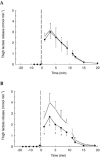Cytochrome P450 2C9 plays an important role in the regulation of exercise-induced skeletal muscle blood flow and oxygen uptake in humans
- PMID: 12509498
- PMCID: PMC2342472
- DOI: 10.1113/jphysiol.2002.030833
Cytochrome P450 2C9 plays an important role in the regulation of exercise-induced skeletal muscle blood flow and oxygen uptake in humans
Abstract
Previous studies show that exercise-induced hyperaemia is unaffected by systemic inhibition of nitric oxide synthase (NOS) and it has been proposed that this may be due to compensation by other vasodilators. We studied the involvement of cytochrome P450 2C9 (CYP 2C9) in the regulation of skeletal muscle blood flow in humans and the interaction between CYP 2C9 and NOS. Seven males performed knee extensor exercise. Blood flow was measured by thermodilution and blood samples were drawn frequently from the femoral artery and vein at rest, during exercise and in recovery. The protocol was repeated three times on the same day. The first and the third protocols were controls, and in the second protocol either the CYP 2C9 inhibitor sulfaphenazole alone, or sulfaphenazole in combination with the NOS inhibitor N(omega)-monomethyl-L-arginine (L-NMMA) were infused. Compared with control there was no difference in blood flow at any time with sulfaphenazole infusion (P > 0.05) whereas with infusion of sulfaphenazole and L-NMMA, blood flow during exercise was 16 +/- 4 % lower than in control (9 min: 3.67 +/- 0.31 vs. 4.29 +/- 0.20 l min(-1); P < 0.05). Oxygen uptake during exercise was 12 +/- 3 % lower (9 min: 525 +/- 46 vs. 594 +/- 24 ml min(-1); P < 0.05) with co-infusion of sulfaphenazole and L-NMMA, whereas oxygen uptake during sulfaphenazole infusion alone was not different from that of control (P > 0.05). The results demonstrate that CYP 2C9 plays an important role in the regulation of hyperaemia and oxygen uptake during exercise. Since inhibition of neither NOS nor CYP 2C9 alone affect skeletal muscle blood flow, an interaction between CYP 2C9 and NOS appears to exist so that a CYP-dependent vasodilator mechanism takes over when NO production is compromised.
Figures




Similar articles
-
Skeletal muscle blood flow and oxygen uptake at rest and during exercise in humans: a pet study with nitric oxide and cyclooxygenase inhibition.Am J Physiol Heart Circ Physiol. 2011 Apr;300(4):H1510-7. doi: 10.1152/ajpheart.00996.2010. Epub 2011 Jan 21. Am J Physiol Heart Circ Physiol. 2011. PMID: 21257921
-
Nitric oxide- and EDHF-mediated arteriolar tone in uremia is unaffected by selective inhibition of vascular cytochrome P450 2C9.Kidney Int. 2005 May;67(5):1907-12. doi: 10.1111/j.1523-1755.2005.00289.x. Kidney Int. 2005. PMID: 15840038
-
Cytochrome P-450 2C9 exerts a vasoconstrictor influence on coronary resistance vessels in swine at rest and during exercise.Am J Physiol Heart Circ Physiol. 2012 Apr 15;302(8):H1747-55. doi: 10.1152/ajpheart.00648.2011. Epub 2012 Feb 3. Am J Physiol Heart Circ Physiol. 2012. PMID: 22307673
-
Skeletal muscle blood flow in humans and its regulation during exercise.Acta Physiol Scand. 1998 Mar;162(3):421-36. doi: 10.1046/j.1365-201X.1998.0293e.x. Acta Physiol Scand. 1998. PMID: 9578388 Review.
-
Adenosine and nitric oxide in exercise-induced human skeletal muscle vasodilatation.Acta Physiol Scand. 2000 Apr;168(4):575-91. doi: 10.1046/j.1365-201x.2000.00705.x. Acta Physiol Scand. 2000. PMID: 10759594 Review.
Cited by
-
Maximal exercise and plasma cytochrome P450 and lipoxygenase mediators: a lipidomics study.Physiol Rep. 2019 Jul;7(13):e14165. doi: 10.14814/phy2.14165. Physiol Rep. 2019. PMID: 31304687 Free PMC article.
-
The effect of purinergic P2 receptor blockade on skeletal muscle exercise hyperemia in miniature swine.Eur J Appl Physiol. 2014 Oct;114(10):2147-55. doi: 10.1007/s00421-014-2932-8. Epub 2014 Jun 25. Eur J Appl Physiol. 2014. PMID: 24962002
-
Endothelium-dependent vasodilatation and exercise hyperaemia in ageing humans: impact of acute ascorbic acid administration.J Physiol. 2009 May 1;587(Pt 9):1989-2003. doi: 10.1113/jphysiol.2008.167320. Epub 2009 Mar 23. J Physiol. 2009. PMID: 19307300 Free PMC article.
-
Vasodilator interactions in skeletal muscle blood flow regulation.J Physiol. 2012 Dec 15;590(24):6297-305. doi: 10.1113/jphysiol.2012.240762. Epub 2012 Sep 17. J Physiol. 2012. PMID: 22988140 Free PMC article. Review.
-
Cyp1b1-deficient retinal astrocytes are more proliferative and migratory and are protected from oxidative stress and inflammation.Am J Physiol Cell Physiol. 2019 Jun 1;316(6):C767-C781. doi: 10.1152/ajpcell.00021.2019. Epub 2019 Mar 20. Am J Physiol Cell Physiol. 2019. PMID: 30892936 Free PMC article.
References
-
- Andersen P, Adams RP, Sjogaard G, Thorboe A, Saltin B. Dynamic knee extension as model for study of isolated exercising muscle in humans. J Appl Physiol. 1985;59:1647–1653. - PubMed
-
- Bauersachs J, Popp R, Hecker M, Sauer E, Fleming I, Busse R. Nitric oxide attenuates the release of endothelium-derived hyperpolarizing factor. Circulation. 1996;94:3341–3347. - PubMed
-
- Bolz SS, Fisslthaler B, Pieperhoff S, De Wit C, Fleming I, Busse R, Pohl U. Antisense oligonucleotides against cytochrome P450 2C8 attenuate EDHF-mediated Ca2+ changes and dilation in isolated resistance arteries. FASEB Journal. 2000;14:255–260. - PubMed
Publication types
MeSH terms
Substances
LinkOut - more resources
Full Text Sources
Medical
Miscellaneous

